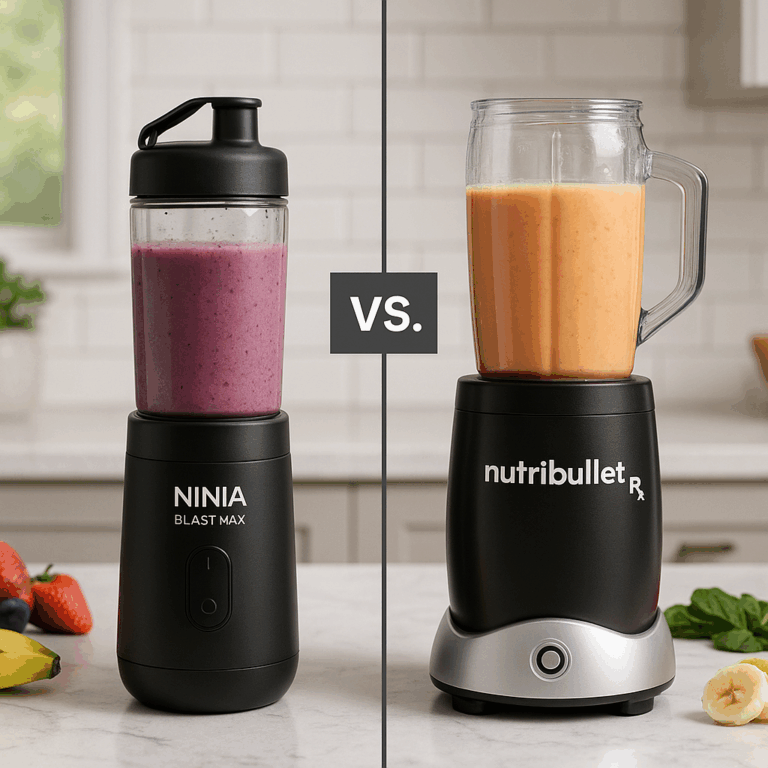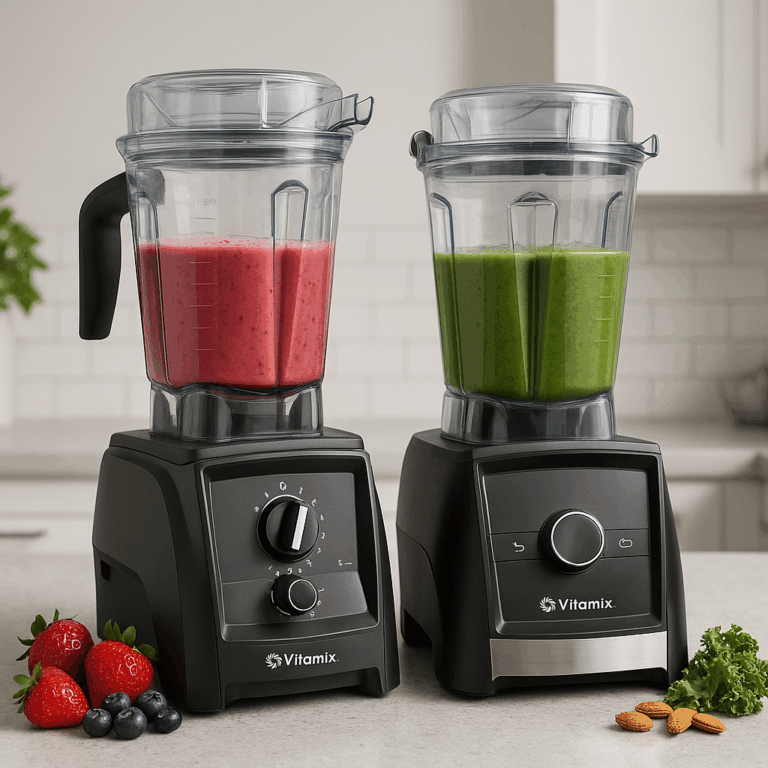Blenders have come a long way from being bulky machines limited to kitchen counters. The market currently offers an incredible range of both portable blenders and countertop blenders, each designed to meet different user needs. But with so many options, it can be difficult to choose which type is best for your lifestyle. Should you go with a convenient, USB-rechargeable personal blender or invest in a full-size kitchen powerhouse?
If you’re looking to explore all types of blenders, including specialty and high-powered models, browse our full blender reviews for in-depth reviews and comparisons.
This guide will break down the pros and cons of portable vs countertop blenders, comparing real-world use cases, performance, design, and value to help you make an informed choice.
Table of Contents
What Is a Portable Blender?
Portable blenders are compact, cordless blending devices designed for people on the move. They usually have:
- A small motor base powered by a rechargeable battery
- A single-serve blending cup (usually 12 to 20 oz)
- Lightweight and easy-to-carry designs
They’re ideal for:
- Gym-goers
- Office use
- Travelers
- Quick shakes or smoothies during a commute
What Is a Countertop Blender?
Countertop blenders are larger, more powerful machines built to handle everything from smoothies and frozen drinks to soups, sauces, and nut butters. They typically include:
- High-wattage motors (1000W+)
- Large pitchers (48–72 oz)
- Multiple speed settings and preset programs
They’re ideal for:
- Family-sized servings
- Batch prepping
- Cooking and meal preparation
- Heavy-duty use
Performance Comparison
Blending Power
Portable Blenders: Best for soft ingredients like bananas, protein powder, and yogurt. They can struggle with ice, frozen fruit, or fibrous greens.
Countertop Blenders: Designed to crush ice, pulverize seeds, and blend thick, frozen mixes with ease. Models like the Ninja TWISTi or Vitamix Explorian Blender can power through almost anything.
Speed and Texture
Portable units usually have a single button and one blend mode. They require more manual shaking or extra blending cycles to reach a smooth consistency. Countertop blenders offer multiple speeds and preset programs, resulting in smoother textures faster.
Use Case Breakdown
When Portable Blenders Are Better
- You need quick post-workout shakes
- You want to blend while traveling
- You live in a dorm or have limited kitchen space
- You don’t want to clean a big pitcher daily
Example: The Ninja Blast Max is a compact, rechargeable option that fits in your gym bag and blends single-serving smoothies in under 30 seconds.
When Countertop Blenders Are Better
- You blend every day or for more than one person
- You want to make soups, dips, or nut butters
- You need precise control (variable speeds, pulse)
- You prep meals or smoothies in bulk
Example: The Ninja BN751 features a 1400-watt motor and Auto-iQ technology that handles frozen fruits and ice without bogging down. Check our full Auto-iQ Ninja BN751 blender review for details.
Cleaning and Convenience
Portable Blenders
- Fewer parts = easier cleanup
- Smaller cups can be rinsed or placed in the dishwasher
- Rechargeable (USB-C)
Countertop Blenders
- More parts to clean (pitcher, blades, lid)
- Takes up more space on the counter
- Often have self-cleaning modes (add water + soap and blend)
Durability and Cost
Portable Blenders
- Budget-friendly
- Ideal for light, occasional use
- Not meant for daily heavy-duty blending
Countertop Blenders
- Higher cost upfront
- Long-term investment
- More durable with strong motors and reinforced blades
Noise Level
Portable blenders are generally quieter because of their smaller motors. Countertop models, especially high-powered ones, tend to be louder but finish the job faster.
If you live with others or need something discreet, portability may win here. However, newer countertop designs like the KitchenAid K400 countertop blender are engineered to minimize noise.
Real-Life Scenarios
Scenario 1: Morning Rush
If you’re rushing to the gym and just want to whip up a protein shake, a portable blender is faster, quieter, and easier to clean.
Scenario 2: Weekend Meal Prep
You’re blending smoothies for the family, prepping salsa, and making soup. A countertop blender’s capacity and strength will save you time and frustration.
Scenario 3: Traveling
For road trips, camping, or office use, a compact portable blender keeps you consistent with your nutrition goals anywhere you go.
Scenario 4: Small Apartment Living
If counter space is tight, a portable blender like the Ninja Blast Max is easier to store and use without committing valuable real estate.
Pros and Cons Summary
Portable Blenders
Pros:
- Lightweight and compact
- Rechargeable and cordless
- Great for single-serve use
- Easy to clean
Cons:
- Limited power and capacity
- Not suitable for tough blends
- Slower and less consistent texture
Countertop Blenders
Pros:
- High power for tough ingredients
- Larger capacity for families or prep
- Presets and manual controls
- Long-lasting performance
Cons:
- More expensive
- Takes up counter space
- Louder and more to clean
Final Verdict: Which One Should You Buy?
If you’re blending on the go, traveling, or only making one shake at a time, a portable blender is a smart, low-commitment option. It’s budget-friendly, easy to clean, and gets the job done for basic tasks.
But if you’re looking to blend daily, prepare meals in bulk, or create a wider range of recipes, a countertop blender gives you the power, control, and reliability needed for long-term use.
Recommendation:
- Choose Portable if convenience, portability, and simplicity are your top priorities.
- Choose Countertop if performance, volume, and versatility matter most.
For example, pair a Ninja Blast Max with a Ninja BN751 and you’ve got both ends of the spectrum covered: power at home and convenience on the go. If you’re still unsure which blender type fits your needs, visit our powerful blender comparison center for detailed side-by-side matchups and expert reviews.
Frequently Asked Questions
Are portable blenders powerful enough for frozen fruit?
Most portable blenders can handle soft frozen fruit like bananas or mango chunks, but they may struggle with ice or very dense ingredients. Letting frozen items thaw slightly helps.
Can a portable blender replace a countertop blender?
Not entirely. While they’re great for quick shakes or light smoothies, they lack the motor strength and capacity of full-size models. They’re more of a complement than a replacement.
Are countertop blenders worth the investment?
Yes, especially if you blend daily, cook from scratch, or need to prepare multiple servings. They’re more durable, versatile, and consistent.
What’s easier to clean: portable or countertop blenders?
Portable blenders are typically easier and faster to clean. However, many countertop models now feature self-cleaning modes for added convenience.
Can you travel with a countertop blender?
Technically, yes, but they’re bulky and require outlets. A portable blender is better suited for travel, camping, or office use.


